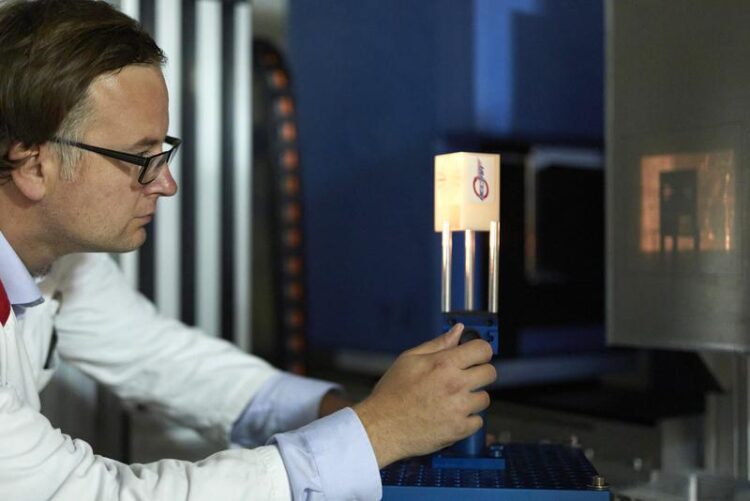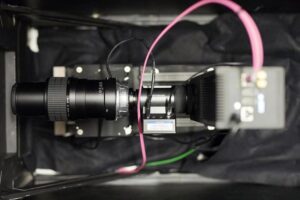Revolution in imaging with neutrons

Instrument scientist Adrian Losko at the neutron radiography instrument NECTAR at the Research Neutron Source Heinz Maier-Leibnitz (FRM II) at the Technical University of Munich
Credit: Bernhard Ludewig / FRM II / TUM
FRM II research group develops new processing method for image data.
Technology could not only improve the resolution of neutron measurements but could also reduce radiation exposure during x-ray imaging.
An international research team at the Research Neutron Source Heinz Maier-Leibnitz (FRM II) of the Technical University of Munich (TUM) have developed a new imaging technology. In the future this technology could not only improve the resolution of neutron measurements by many times but could also reduce radiation exposure during x-ray imaging.

Credit: Bernhard Ludewig / FRM II / TUM
Modern cameras still rely on the same principle they used 200 years ago: Instead of a piece of film, today an image sensor is exposed for a certain period of time in order to record an image. However, the process also records the noise of the sensor. This constitutes a considerable source of interference especially with longer exposure times.
Together with colleagues from Switzerland, France, the Netherlands and the USA, Dr. Adrian Losko and his TUM colleagues at the Heinz Maier-Leibnitz Zentrum (MLZ) have now developed a new imaging method which measures individual photons on a time-resolved and spatially-resolved basis. This makes it possible to separate photons from noise, greatly reducing the interference.
“Our new detector lets us capture every individual photon and thus overcome many of the physical limitations of traditional cameras,” says Dr. Adrian Losko, instrument scientist at the NECTAR neutron radiography facility of the Heinz Maier-Leibnitz Zentrum at the Technical University of Munich.
Measuring individual photons
Neutron radiography researchers typically use scintillators in their measurements to detect neutrons for example in the examination of fossilized dinosaur eggs. When the scintillator material absorbs a neutron, photons are generated which can then be measured.
Until now all of these cameras have collected light during the entire exposure time, resulting in a lack of definition, depending on the thickness of the scintillator. The research team’s new concept on the other hand detects each individual photon generated by a neutron.
“The prerequisite was a new chip technology as well as hardware and software that support computing speeds which enable real-time analysis. This lets us compose an image neutron by neutron,” explains Losko. Here neutron research offers an ideal test and application field.
Instead of longer exposure times: Measuring exactly what happens
Since the absorption of a neutron in the detector generates several photons, the new system can use coincidence measurement of several photons to determine individual neutrons. “This takes us away from the traditional model of exposure time and we measure only those events which have occurred.”
Compared to all technologies previously available on the market, the new concept is a dramatic improvement since it enables three times better spatial resolution and reduces the amount of noise by more than seven times. “This greatly reduces the limitations resulting from the thickness of the scintillator, which means higher efficiency for high-resolution measurements,” says Losko. And the afterglow of the scintillator, which creates what are referred to as ghost images, is eliminated as well.
“Many of the instruments at the research neutron source reactor can benefit from our new concept,” observes Losko, citing as an example the instrument FaNGaS (Fast Neutron-induced Gamma-ray Spectrometry): “Since we know exactly when a neutron arrives, the time-span during which we measure the gamma particle can be reduced to a millionth of a second.” This would reduce the background noise by a factor of one million, he adds.
Lower radioactive exposure and more details in x-rays
The new detector can also be applied in medical fields. When making an x-ray image of a broken bone for example, fine structures such as hairline fractures would be more easily detectable; at the same time, the patient’s exposure to radiation would be minimized.
“Our method will definitely change detectors in the scientific world,” says Losko. And perhaps similar principles will also make their way into application in everyday cameras for personal use. Images made in the dark would be greatly improved, and photographers could adjust exposure time and resolution after the exposure is made. Noise could be practically eliminated from cameras.
The research activities were supported by German Federal Ministry of Education and Research (BMBF). In addition to the scientists of the Research Neutron Source Heinz Maier-Leibnitz (FRM II) at the Technical University of Munich, researchers at the Paul Scherrer Institute PSI in Villigen, Switzerland, Amsterdam Scientific Instruments B.V. (Netherlands) and the Space Sciences Laboratory of the University of California, Berkeley (USA), were also involved in the project.
Journal: Scientific Reports
DOI: 10.1038/s41598-021-00822-5
Method of Research: Experimental study
Subject of Research: Not applicable
Article Title: New perspectives for neutron imaging through advanced event-mode data acquisition
Article Publication Date: 1-Nov-2021
COI Statement: The authors declare no competing interests.
Media Contact
Andreas Battenberg
Technical University of Munich (TUM)
battenberg@zv.tum.de
Office: 49-892-891-0510
All latest news from the category: Physics and Astronomy
This area deals with the fundamental laws and building blocks of nature and how they interact, the properties and the behavior of matter, and research into space and time and their structures.
innovations-report provides in-depth reports and articles on subjects such as astrophysics, laser technologies, nuclear, quantum, particle and solid-state physics, nanotechnologies, planetary research and findings (Mars, Venus) and developments related to the Hubble Telescope.
Newest articles

Innovative 3D printed scaffolds offer new hope for bone healing
Researchers at the Institute for Bioengineering of Catalonia have developed novel 3D printed PLA-CaP scaffolds that promote blood vessel formation, ensuring better healing and regeneration of bone tissue. Bone is…

The surprising role of gut infection in Alzheimer’s disease
ASU- and Banner Alzheimer’s Institute-led study implicates link between a common virus and the disease, which travels from the gut to the brain and may be a target for antiviral…

Molecular gardening: New enzymes discovered for protein modification pruning
How deubiquitinases USP53 and USP54 cleave long polyubiquitin chains and how the former is linked to liver disease in children. Deubiquitinases (DUBs) are enzymes used by cells to trim protein…


